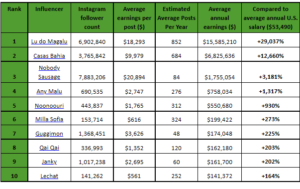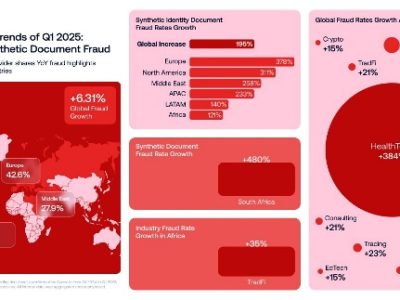Influencer marketing is altering Nigeria and rest of Africa’s landscape with an increasing number of the continent’s over 1.4 billion people going online. There is a rising use of social media influencers seek to expand or dominate market.
Major influencers in Nigeria include, actors, comedians, musicians and bloggers. The top 10 influencers jointly have in excess of 150 million followers to go by Instagram record. They include Davido, Funde Akindele, Wizkid, Linda Ikeji, Yemi Alade, Tiwa Savage, Ayo Makun and Don Jazzy.
A case study report for Jumia Nigeria showed that influencer marketing accounts for 60-70% of Jumia’s “marketing plan and has significantly increased their brand visibility on social media platforms like Instagram.”
According to Statsmetrics, the number of online shoppers will also surpass 2.64 billion people in 2023, making collaborating with influencers an essential strategy to boost brand awareness, engagements, and sales.
This AI influencer could earn $15 million a year on Instagram
Online influencers are dominating social media, posting snippets of their enviable lifestyles while raking in the cash has become the norm. But, some of the personalities we see only exist in the digital world. And they could be making millions.
RELATED: Chinese, US, and UK brands generate two-thirds of total influencer ad spending, worth $30.8b in 2023
Interested, Scams.info calculated how much Instagram’s most popular virtual influencers could be making from sponsored posts, and provided their expertise on how you can spot a fake influencer account, specifically from those that look way too real.
Highlights from the research:
- Brazilian social media star Lu do Magalu could earn the most on Instagram ($15.58 million a year), 29,037% more than the average U.S. salary
- Casas Bahia is second, earning $6.82 million a year (12,660% more than the average U.S. salary)
- Nobody Sausage has the most Instagram followers (7.83 million) meaning he could earn the most per post ($20.8K)
- Qai Qai could earn just $480 more than Janky below in ninth place, despite Janky having 3x more followers (1,017,238)
How much could Instagram’s most popular virtual influencers earn in a year?

Please find the full dataset here.
Lu do Magalu – $15.5 million
Via: Instagram @magazineluiza

Via: Instagram @magazineluiza
Scams.info can reveal that Brazilian social media star Lu do Magalu is the highest earning robot influencer, who could earn over $15.58 million a year on Instagram, a massive 29,037% more than the average U.S. salary of $53,490.
Created by Brazilian retail brand Magalu, Lu do Magalu has over 6.9 million Instagram followers, and her content originally focused on content such as unboxing videos and product reviews on behalf of the company, but Lu now also shares her life and takes a stand on political matters, such as advocating for LGBT rights. Lu is no longer just a sales tool, but a fully fledged influencer and personality.
CB of Casas Bahia – $6.8 million

Via: Instagram @casasbahia
In second place is CB, another product of a Brazilian retail giant, this time Casas Bahia. Like Lu do Magalu, CB’s content is not exclusive to product advertisement for the brand; he shares his love of video games, movies, memes and more with his almost 4 million Instagram followers.
This animated virtual teen has the potential to earn over $6.8 million on Instagram alone, though this is 56% less than do Magalu, CB could earn 12,660% more than the average U.S. employee.
Nobody Sausage – $1.75 million

Via: Instagram @nobodysausage
Coming in in third place is virtual influencer Nobody Sausage, who could earn $1.75 million from Instagram posts alone. Created by Portuguese motion graphics designer Kael Cabral in 2020, Nobody’s Sausage’s content is in the form of animated, colorful short-form videos, which aim to make audiences laugh.
Any Malu – $758K

Via: Instagram @anymalu_real
Fourth in the rankings is Any Malu: a virtual influencer turned Cartoon Network star who has the potential to make over $758K annually from her Instagram presence alone. The animated figure from Brazil has over 3.8 million YouTube subscribers as well as 690,000 followers on Instagram.
Originally created by production company Combo Estúdio as a marketing tool, Any Malu began making videos on YouTube and is now the star of her own animated Cartoon Network television show: O (sur)real mundo de Any Malu (English: Any Malu’s Surreal World).
Noonoouri – $550K

Via: Instagram @noonoouri
In fifth spot is Noonoouri: a digital style icon who has made waves in the fashion world. The animated fashionista has worked with the likes of Dior, Valentino, MiuMiu, Kim Kardashian and more; a list that most real-life influencers only dream of. Noonoouri also brings awareness to social issues and advocates for animal rights to her over 440K followers on Instagram.
From her Instagram platform, Noonoouri could be making over $550,000 per year.
Nicholas Crouch, a spokesperson from Scams.info provides expertise on how you can tell if a human-looking virtual influencer account is fake:
- There’s not enough information.
“Fake influencers often present vague profiles, making it difficult to ascertain their identity or find additional online presence. They might also have inconsistent posting patterns that obscure their real interests. For example, genuine influencers like Nobody Sausage include a link to their YouTube channel in their profile. If an influencer’s profile lacks basic details such as a link to a blog, their niche, or even a first name, it’s advisable to consider more transparent alternatives.
- They gained a lot of Instagram followers overnight.
It’s natural that we perceive someone as popular on social media if they have a large follower count, however, thanks to the rise of bots and purchased followers, not all influencers have grown their follower count organically. They can also ‘mass-follow and unfollow’ which is a tactic where accounts will follow several accounts in the hope that they will follow them back, they will then in turn unfollow those accounts, creating the perception of a large follower growth.
A good rule of thumb: If an Instagram account gains more than 10,000 followers in a few days, or especially in just a few hours, there could be something suspicious going on.
- They follow a large proportion of their followers.
Real influencers focus on meaningful engagement with their followers, evident through key metrics like the Follow-to-Follower and Follower-Engagement Ratios. Genuine influencers follow a smaller portion of their audience to maintain a manageable and relevant feed, especially on platforms like Instagram, where the follow limit is set at 7,500. The Follower-Engagement Ratio can be assessed by the interaction in the comments section; sparse replies or simplistic comments often indicate low engagement and possibly a high presence of bot followers.
- Their followers aren’t real either.
Finally, examine the followers of this influencer. Bots, which often follow patterns based on hashtags particularly on platforms like Instagram, which are frequently attracted to fake influencers in large numbers. If you observe many followers with similar usernames and profile pictures, or accounts that have few or no followers themselves, or seem to engage in deceptive practices, it’s likely that the influencer’s follower base does not represent genuine consumers you would want to target.
If this content is of use, please provide a link to https://scams.info who commissioned this research. A linked credit allows us to keep providing you with future content that you may find useful.
Find the full dataset here
Methodology:
- Scams.info wanted to calculate how much virtual influencers could earn from Instagram.
- To do this, they first created a seed list of the most popular virtual influencers from sources including Mandala.ai and Influencer Matchmaker.
- Secondly, they analyzed data from Influencer Marketing Hub and ViralMango which calculates each influencer’s Instagram follower count and average number of likes per Instagram post to calculate the estimated earnings per post.
- Next, they multiplied the number of posts each influencer made in January 2024 and multiplied by 12 to calculate the estimated earnings made in one year if all their posts were sponsored.
- Scams.info then compared this to the average U.S. annual salary to calculate the percentage difference.
- Data was collected on the 17th April 2024 and is accurate as of then, but subject to change.
- This is an update. Published in itedgenews: August 18, 2023 with the title: Pixels to Profits: AI influencers could be raking in $16m a year




























